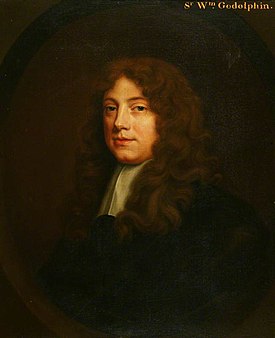William Godolphin (diplomat)

Sir William Godolphin (2 February 1635 – 11 July 1696) was an English diplomat for Charles II and Member of Parliament.
Biography[]
Godolphin was third but eldest surviving son of Sir William Godolphin (1605–1663) of Spargor, Cornwall; the eldest son (by Judith Meredith) of John Godolphin (the younger brother of Sir William Godolphin (1567–1613)—and Ruth (died before 1658), daughter of Sir John Lambe of East Coulston, Wiltshire.[1][2]
Godolphin was baptised 2 February 1634,[3] and was educated at Westminster School and Christ Church, Oxford, gaining the degrees of Master of Arts in 1661 and Doctor of Civil Law in 1663. He became a follower of Lord Arlington,[1] and in 1665 he was elected in a by-election to Parliament as member for Camelford, however as he went to Spain early the next year he probably never took up his seat.[4]
In 1667, he took part in the negotiations under Sandwich which resulted in a commercial treaty with Spain. He was knighted in 1668, and in 1669 was sent as Envoy Extraordinary to Madrid, becoming Ambassador in 1672.[1] However, in 1678 he came under suspicion of having been converted to Catholicism, and was recalled; but rather than return to England, he then openly declared his Catholicism, and retired to Spain for the remaining two decades of his life.[1] Shortly before he died, he made a declaration empowering his spiritual advisers, including the procurator-general of the Jesuits, to make his will after his death; an Act of Parliament was passed in 1697[5] to declare this and other posthumous wills invalid and to make his nephew Francis and niece Elizabeth heirs on condition that £1,520 was devoted to charity, a charitable act leading ultimately to the foundation of Godolphin and Latymer School, Hammersmith, London and Godolphin School, Salisbury.[6][7][8][9][10]
Samuel Pepys, who met him in 1668, called Godolphin "a very pretty and able person, a man of very fine parts".[1]
Notes[]
- ^ Jump up to: a b c d e Leslie 1890, p. 46.
- ^ Venning 2008.
- ^ Leslie 1890, p. 46 cites Maclean, Trigg Minor, ii. 522
- ^ Cruickshanks 1983.
- ^ "1697 (9 Will. 3). c. 19 Confirming and establishing the administration of Sir William Godolphin's goods and chattels". legislation.gov.uk. Parliamentary Archives, Houses of Parliament, London. Retrieved 15 September 2018.
- ^ Leslie 1890, pp. 46–47.
- ^ "Schools: Latymer and Godolphin Schools". British History Online. Institute of Historical Research. Retrieved 15 September 2018.
- ^ "House of Lords Journal Volume 16: 1 April 1698 Pages 253-254". British History Online. Institute of Historical Research. Retrieved 15 September 2018.
- ^ "House of Commons Journal Volume 12: 1 April 1698 Pages 188-189". British History Online. Institute of Historical Research. Retrieved 15 September 2018.
- ^ Douglas, A; Ash, R (eds.). "Elizabeth Godolphin's Will". The Godolphin Book 1726 - 1926. Retrieved 15 September 2018.
References[]
- Cruickshanks, Eveline (1983). "GODOLPHIN, William (1635-96), of Spargor, St. Mabyn, Cornw.". In Henning, Basil Duke (ed.). The History of Parliament: the House of Commons 1660-1690. Secker & Warburg. Retrieved 8 September 2012.
- Leslie, Stephen (1890). . In Stephen, Leslie; Lee, Sidney (eds.). Dictionary of National Biography. 22. London: Smith, Elder & Co. pp. 46–47.
- Venning, Timothy (October 2008) [2004]. "Godolphin, Sir William (bap. 1635, d. 1696)". Oxford Dictionary of National Biography (online ed.). Oxford University Press. doi:10.1093/ref:odnb/10883. (Subscription or UK public library membership required.)
- 1635 births
- 1696 deaths
- English MPs 1661–1679
- Fellows of the Royal Society
- People educated at Westminster School, London
- Alumni of Christ Church, Oxford
- Members of the pre-1707 English Parliament for constituencies in Cornwall
- Ambassadors of England to Spain
- 17th-century English diplomats
- 17th-century English MP stubs
